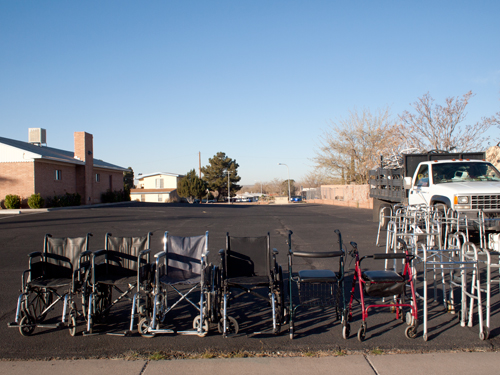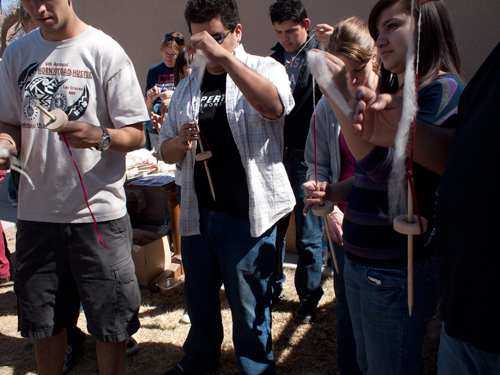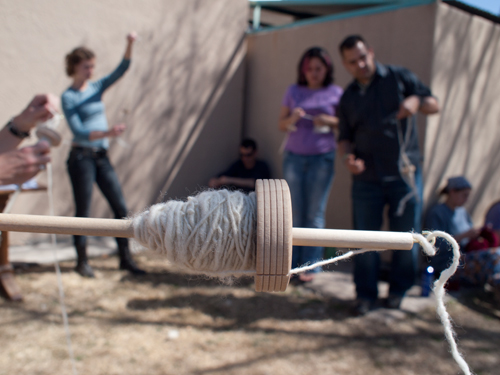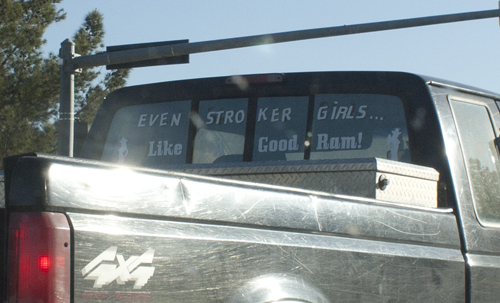I spent a couple of days this week in Las Cruces, New Mexico, visiting New Mexico State University, where the school mascot is a mustachioed man with a handgun named “Pistol Pete.” My explorations of Las Cruces were limited, but I did get an opportunity to visit Kenny, who sells used wheelchairs, shower stools and walkers out of the back of his pickup truck in front of one of the local churches. Kenny told me that he gets the gear from San Antonio, because locally they just cut it up so that people will have to buy it new. He pointed out the different kinds of shower stools, one that will hold a person weighing up to 250 pounds and another to hold a 400 pound person.

The art program at NMSU is fairly large, with around 200 undergraduate art majors and a small group of graduate students. They have programs in metal-smithing, ceramics, painting, photography, conservation, print-making, art history, and drawing, and the students I met were generally dedicated, inquisitive, and hard-working. In two short days, I spoke with eleven students about their work and saw a crosscut of concerns, ranging from pink slime to apocalypse. Many of the students were interested in exploring identity through their work, and several of the women were specifically interested in feminism and ideas about women’s place in a larger society.
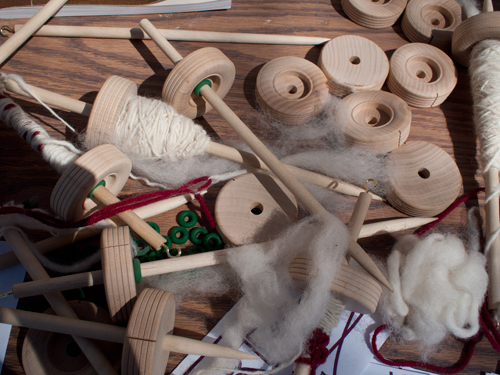
On Tuesday, we set up a table in front of the art building and showed students how to spin wool fiber into yarn at a “Spin-In.” Spinning is a very simple process that is a bit tricky to master. I learned to spin last year, on a wheel. A friend taught me the basics. Spinning is magical and witchy, and the action of spinning is helpful for understanding both the structure of yarn and the history of worldwide textile production. Without spinning, we’d all be naked or clad solely in animal skins. The ability to twist fibers into something that can be woven transformed humanity. It’s impossible to imagine a world without thread, and, when learning to spin for the first time, impossible to understand how this small action could be responsible for the miles of textiles that surround us daily.
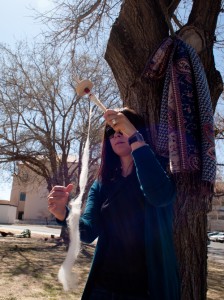
Looking around at a world of blankets, clothing, curtains, and upholstery, it’s easy to see how spinning is a fundamental element of human existence. Attempting to connect with that elemental skill is challenging. Teaching a skill I barely know myself is also a bit difficult, but talking to people about how to spin helped me to understand how to do it better myself. Describing repeatedly the method of drawing out fibers and pinching them to control the twist embedded the skill in my fingers and mind more fully, and seeing the mistakes others were making improved my own understanding of how to making yarn from fiber.
The tools required for spinning are minimal. It’s possible, though tedious, to produce yarn just by twisting the fiber with the hand. Much easier, however, to use a tool of some sort, so for the “Spin-In,” we constructed drop spindles using dowels, toy wheels, and castration rubber bands from the farm supply shop.
The action: pinch, spin, draft, pinch, spin. The twist must be controlled so that it only affects the fibers that are drawn out to be spun. The biggest mistake I saw from beginning spinners was that they often allowed the twist to travel into the bulk of their fiber. That makes a mess instead of making yarn. Once you get the hang of getting the twist to affect specific fibers, the spinner can make decisions about how thick the yarn should be and how tightly twisted. If yarn isn’t twisted enough, it will break. If it’s too twisty, it will twist back on itself into little rat-tails. It’s a delicate balance.
During my visit to NMSU, I knit a bit for Stephanie Taylor’s campus-wide knit-bombing project called “HeARTlines.” Stephanie is encouraging students and community members to knit pieces that will become part of a mile-long, four inch wide band of fabric in the school color “Aggie red.” These will be installed around campus, originating at the art building, in order to bring attention to the idea that the arts connect with every discipline taught at the school. The knit pieces will then be sewn into blankets and donated to various charities around town, bringing this idea into the broader community. Everywhere I went during my visit, students were knitting parts of this project. During my artist talk, I noticed several in the audience knitting with dark red acrylic. Finally, I succumbed to HeARTline fever myself, and began knitting a four inch wide length in moss stitch.
Does anyone know what a “stroker girl” is? I wasn’t quite sure what this provocative sentence meant. Does it have to do with farming? Diesel engines? Strippers? If it makes any difference, it was a woman driving the vehicle. If you have any ideas about this, please get in touch by leaving a comment below.

